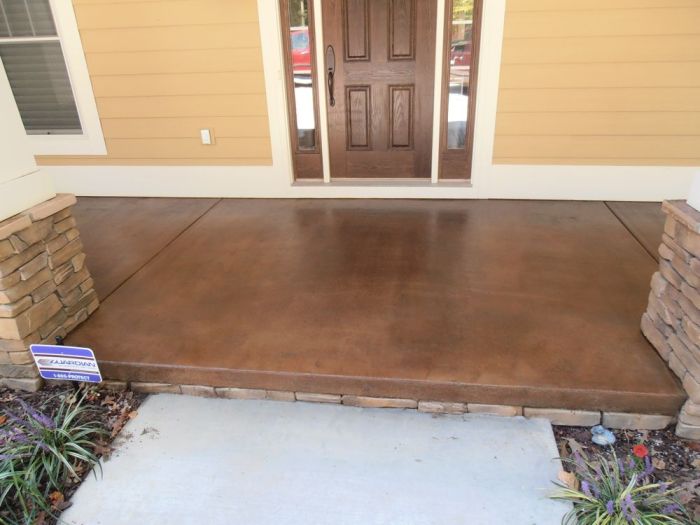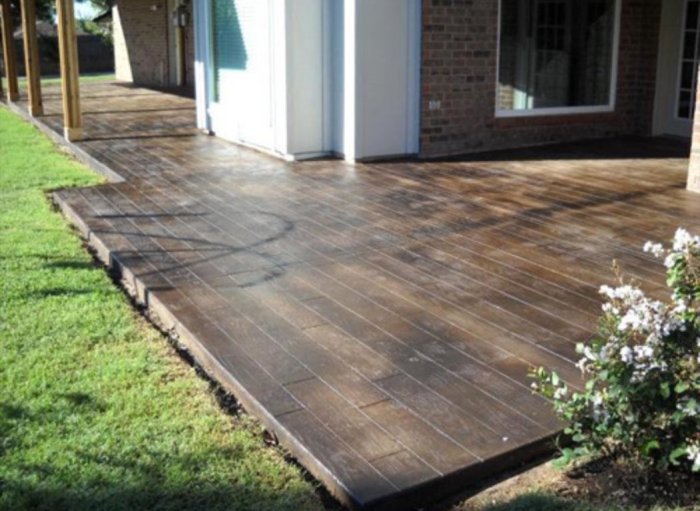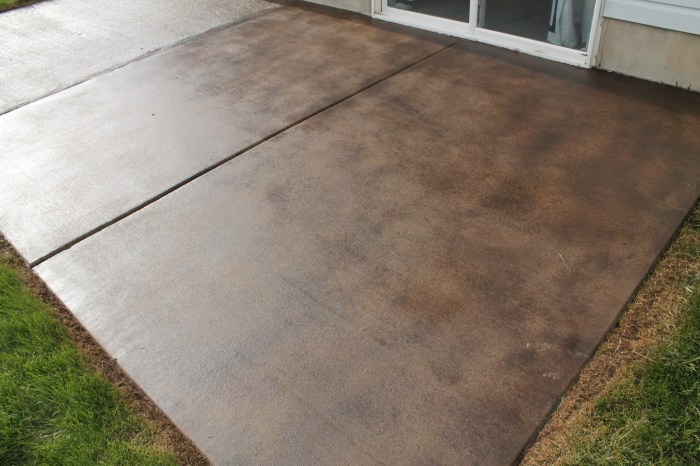Elevate the aesthetics and functionality of your outdoor living area with the art of staining concrete porches. This practical and versatile technique not only enhances the appearance of your porch but also protects it from wear and tear, ensuring its longevity and beauty for years to come.
From classic solid hues to intricate patterns, staining a concrete porch offers endless possibilities to customize and complement the architectural style of your home. Whether you seek a subtle refresh or a dramatic transformation, this guide will provide you with all the essential knowledge and techniques to achieve a stunning and durable finish.
Introduction
Concrete porch staining is the process of applying a colored liquid to a concrete surface to change its appearance and protect it from the elements. Staining a concrete porch can enhance its aesthetic appeal, make it more resistant to wear and tear, and extend its lifespan.
Purpose of Staining a Concrete Porch
There are several reasons why you might want to stain your concrete porch:
- Enhance the appearance: Staining can give your porch a new look, whether you want to match it to your home’s exterior or create a contrasting accent.
- Protect the concrete: Stains can help protect the concrete from damage caused by UV rays, moisture, and chemicals.
- Increase durability: Stained concrete is more resistant to wear and tear, making it less likely to crack or chip.
- Extend the lifespan: By protecting the concrete from damage, staining can help extend its lifespan, saving you money on repairs and replacements.
Preparation
Preparing a concrete porch for staining is crucial to ensure the stain adheres properly and provides a long-lasting finish. It involves thoroughly cleaning and etching the concrete to remove dirt, debris, and sealers, and to create a slightly rough surface that will allow the stain to penetrate.
Cleaning the concrete is essential to remove any surface contaminants that could interfere with the stain’s adhesion. This can be done using a pressure washer or a stiff-bristled brush and a cleaning solution specifically designed for concrete. It’s important to rinse the concrete thoroughly after cleaning to remove any residual cleaning solution.
Etching the Concrete
Etching the concrete is the next step in preparing it for staining. This process involves applying a chemical solution to the concrete that reacts with the surface and creates a slightly rough texture. Etching helps to open up the pores of the concrete, allowing the stain to penetrate more deeply and evenly.
There are different types of etching solutions available, each with its own strengths and weaknesses. Muriatic acid is a commonly used etching solution that is effective at removing dirt, debris, and sealers. However, it is important to use muriatic acid with caution as it can be harmful if not handled properly.
Other etching solutions, such as phosphoric acid or sodium hydroxide, are also available and may be more suitable for certain types of concrete.
Once the concrete has been etched, it should be rinsed thoroughly with water to remove any residual etching solution. It is important to allow the concrete to dry completely before applying the stain.
Stain Selection
Choosing the right stain for your concrete porch is crucial to enhance its appearance and protect it from the elements. Various types of stains are available, each with unique properties and benefits. Consider the following factors when selecting a stain:
Type of Concrete: Determine the type of concrete you have, such as smooth or textured, as this will influence the stain’s penetration and adhesion.
Desired Finish: Decide on the desired finish, whether it’s a solid color, semi-transparent, or textured look. Different stains offer varying levels of opacity.
Durability: Consider the level of traffic and exposure your porch receives. Choose a stain that provides adequate protection from wear and tear.
Environmental Concerns: Opt for eco-friendly stains that minimize the release of harmful chemicals into the environment.
Types of Stains
- Water-Based Stains: Easy to apply, penetrate deeply, and are available in a wide range of colors. However, they may not be as durable as other options.
- Solvent-Based Stains: Offer better penetration and durability, but have a stronger odor and require proper ventilation during application.
- Acid-Based Stains: React chemically with the concrete, creating permanent colors. They are highly durable but can be more challenging to apply.
- Epoxies: Form a protective coating over the concrete, providing excellent durability and resistance to chemicals and wear.
Application Techniques
Applying stain to a concrete porch requires careful consideration of techniques to achieve a uniform and durable finish. Various tools and methods are available, each with its advantages and considerations.
Brushes
Brushes provide precise control over the application, allowing for detailed work and touch-ups. Natural-bristle brushes are recommended for oil-based stains, while synthetic brushes work well with water-based stains. Use a brush with a wide surface area for larger areas and a smaller brush for intricate designs.
Rollers
Rollers offer a faster and more even application over larger surfaces. Choose a roller with a nap length suitable for the texture of the concrete. A thicker nap is better for rough surfaces, while a thinner nap is ideal for smoother surfaces.
Use a paint tray to evenly distribute the stain onto the roller.
Sprayers
Sprayers provide a quick and efficient way to cover large areas. However, they require proper ventilation and protective gear due to overspray. Use a sprayer specifically designed for concrete stains and adjust the nozzle to control the spray pattern. Practice on a small area first to ensure a consistent application.
Regardless of the technique chosen, always test the stain on an inconspicuous area first to check for color and adhesion. Apply the stain in thin, even coats, allowing each coat to dry thoroughly before applying the next.
Maintenance and Care
Maintaining a stained concrete porch requires regular cleaning and occasional resealing to preserve its appearance and longevity. By following proper maintenance practices, you can extend the lifespan of your stained concrete porch and keep it looking its best.
To clean your stained concrete porch, use a mild detergent and water solution. Avoid using harsh chemicals or abrasive cleaners, as these can damage the stain. Sweep or hose off any loose dirt or debris before cleaning, and rinse the porch thoroughly after cleaning to remove any remaining detergent.
Resealing the Stain
Resealing the stain on your concrete porch is an important part of maintenance. Resealing helps to protect the stain from wear and tear, and it can also help to prevent fading. The frequency with which you need to reseal your porch will depend on the type of stain you used and the amount of traffic it receives.
However, as a general rule, you should reseal your porch every two to three years.
To reseal your porch, follow the instructions on the product label. Be sure to clean the porch thoroughly before applying the sealer, and allow the sealer to dry completely before using the porch.
Preventing Damage and Fading
There are a few things you can do to prevent damage and fading to your stained concrete porch:
- Avoid placing heavy objects on the porch.
- Protect the porch from direct sunlight by using a shade or awning.
- Apply a concrete sealer to the porch to help protect it from moisture and stains.
Design Ideas
Stained concrete porches offer a plethora of design possibilities, allowing you to customize your outdoor space to reflect your personal style. Explore various color schemes and patterns to create a unique and eye-catching porch.
Color Options
The color of your stained concrete porch can significantly impact the overall ambiance. Consider warm hues like terracotta, beige, or honey for a cozy and inviting feel. Alternatively, opt for cool shades like gray, blue, or green to create a refreshing and serene atmosphere.
Patterns and Textures
Incorporate patterns and textures into your stained concrete porch to add depth and interest. Geometric designs, such as stripes, checkers, or diamonds, can create a modern and sophisticated look. Stenciled patterns, like floral motifs or animal prints, add a touch of whimsy and charm.
Examples of Stained Concrete Porches
- A traditional porch with a warm brown stain, complemented by white trim and black accents.
- A modern porch with a cool gray stain, featuring geometric patterns in black and white.
- A rustic porch with a natural stone-like stain, adorned with stenciling in a floral design.
Final Summary
By following the steps Artikeld in this guide, you can transform your concrete porch into an inviting and stylish extension of your home. Embrace the power of staining to create a unique outdoor space that reflects your personal style and enhances your outdoor living experience.



